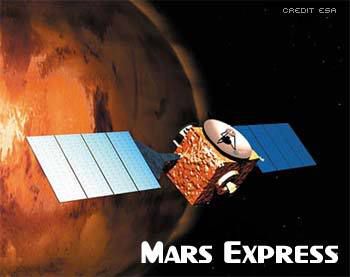-
 Electromagnetic field
Electromagnetic field
-
 Antioxidants
Antioxidants
-
 Micturition
Micturition
-
 Micro-robotics
Micro-robotics
-
 Order
Order
-
 Squark
Squark
-
 Regioselective
Regioselective
-
 Homogamy
Homogamy
-
 Scambaiting
Scambaiting
-
 Haem
Haem
-
 Dolerite
Dolerite
-
 Primate
Primate
-
 Zenith
Zenith
-
 Lacto-vegetarian
Lacto-vegetarian
-
 ESTEC
ESTEC
-
 Cambrian
Cambrian
-
 Bryophyte
Bryophyte
-
 Endoscopy
Endoscopy
-
 Gravity Probe B
Gravity Probe B
-
 Sea ice - Grey
Sea ice - Grey
-
 Enuresis
Enuresis
-
 Magnetic reconnection
Magnetic reconnection
-
 CENELEC
CENELEC
-
 Menstrual cycle
Menstrual cycle
-
 Xylene
Xylene
-
 Prompt
Prompt
-
 Off-shore
Off-shore
-
 Agroenergy
Agroenergy
-
 Calendering
Calendering
-
 Air
Air
Mars Express
After the failure of the Russian MARS-96 mission, the European Space Agency exceptionally decided to take over the scientific objectives of this mission. Thus in June 1997, the ESA decided on the Mars Express mission, using some of the spare instruments from the defunct Russian mission. Mars Express is composed of an orbiter carrying a payload of seven instruments and a lander, the Beagle 2, under British responsibility.
The Mars Express mission was launched in June 2003 and put into orbit around Mars on 25 December 2003. It was carrying the now defunct Beagle 2. The orbiter has the task of carrying out:
* high resolution mapping (10 metres) and for certain sites mapping with a very high 2 metre resolution; mineralogical mapping with a 300 metre resolution;
* a study of the circulation and composition of the global atmosphere;
* probing of the subsoil using radar waves to detect water ice and water in the first kilometre below the surface;
* and a study of the surface - atmosphere interactions and the interactions of the atmosphere with the interplanetary medium.
Scientific questions
One of the major challenges of Mars Express - each instrument is related to it in one way or another - firstly concerns water. In solid or perhaps even liquid form, in the subsoil, the scientists hope to find vital information on the possible evolution of life on Mars. This is because it is believed that water flowed on the red planet 3.8 billion years ago; at about the same time that life appeared on Earth. Furthermore, the possibility of a subterranean form of life sheltered from the intense solar radiation, cannot be ruled out ...
 Mars Express
Mars Express
Latest
Fill out my online form.



